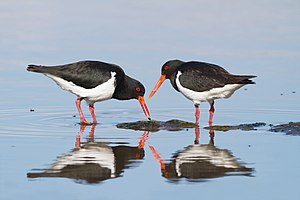Australian oystercatcher
| Australian oystercatcher | ||||||||
|---|---|---|---|---|---|---|---|---|

Australian oystercatchers |
||||||||
| Systematics | ||||||||
|
||||||||
| Scientific name | ||||||||
| Haematopus longirostris | ||||||||
| Vieillot , 1817 |
The Australian oystercatchers ( Haematopus longirostris ) is a bird art from the family of oystercatchers and the order of Regenpfeiferartigen .
description
The Australian oystercatcher reaches a body length of 42 to 50 centimeters. The wingspan is 85 to 95 centimeters. The weight is between 650 and 750 grams.
As an adult, the Australian oystercatcher has black and white plumage. The top of the torso and wings, as well as the head, neck, and chest are black. The underside of the trunk is white, in front of the wing bend the white stripe typical of oystercatchers runs. When the wings are spread out, a white wing stripe on the inner arm wing can be seen on the upper side. The white rump and the white upper tail covers also stand out. The feet do not reach the tip of the tail in flight. The orange-red beak is long, massive and shiny. The strong legs are pink. A red iris is surrounded by an orange-red eye ring. The male has a smaller and wider beak than the female, the latter being slightly larger. Otherwise there are no external differences between the sexes. Young birds are generally more brown in color, wing and coat feathers have a brown edge. The transition from black on the chest to the white belly is washed out. The beak is dull orange to yellow-pink, the tip of the upper beak has a brownish color. There are also differences in the eye: the iris is brown and the eye ring is pale orange. Immature birds resemble both adult and young birds in plumage. The development of the adult bird's appearance takes several years.
Possible confusion
It differs from the South Island oystercatcher , which occasionally appears as a guest on Australian coasts, in its shorter and more powerful beak, the tip of which is thickened and not pointed as in the New Zealand species. The legs are longer.
voice
His voice is described as a high-pitched, explosive whistle.
distribution and habitat
The Australian oystercatcher can be found along the entire coastline of Australia and Tasmania . He also lives on the coasts of southern New Guinea , the Aru Islands and the Kai Islands . It inhabits mainly sandy coasts, rocky coasts and mud flats . The world population is estimated at 11,000 birds, of which about 10,000 live in Australia.
Way of life
The species feeds mainly on cockles . With its powerful beak, it is able to pull the animals out of the ground and hammer the hard shells open.
Outside of the breeding season it is more sociable than inside, the birds then form small groups.
The breeding season is anytime between June and January. The nest is a shallow hollow in the ground in open terrain (coasts, lagoons, estuaries). It is usually built close to the coast and just above the high water line. The clutch consists of 2 eggs. The breeding season lasts 26 to 29 days. The monogamous couple defends their breeding ground from intruders. Usually the same breeding area is used for years. When danger threatens, they show distraction or attack the enemy. The young birds are able to fly after 49 to 56 days.
Danger
The species is listed as "not endangered" in the IUCN Red List . In New South Wales the species is classified as "Endangered".
literature
- Geering, Agnew, Harding: Shorebirds of Australia. CSIRO Publishing, 2007, ISBN 0643092269 .
- PJ Higgins (Ed.): Handbook of Australian, New Zealand & Antarctic Birds. Volume 2: Raptors to Lapwings. Oxford University Press, Oxford 1993, ISBN 0-19-553069-1 .
Web links
- Description of the species .
- Haematopus longirostris in the endangered Red List species the IUCN 2011. Posted by: BirdLife International, 2009. Accessed November 14, 2011th
Individual evidence
- ↑ a b c Geering, Agnew, Harding, p. 174
- ↑ Higgins (Ed.): Handbook of Australian, New Zealand & Antarctic Birds . Volume 2, p. 716.
- ↑ a b c Geering, Agnew, Harding, p. 175
- ↑ Higgins (Ed.): Handbook of Australian, New Zealand & Antarctic Birds . Volume 2, p. 717.
- ↑ Geering, Agnew, Harding, pp. 174-175
- ↑ a b Geering, Agnew, Harding, p. 18


